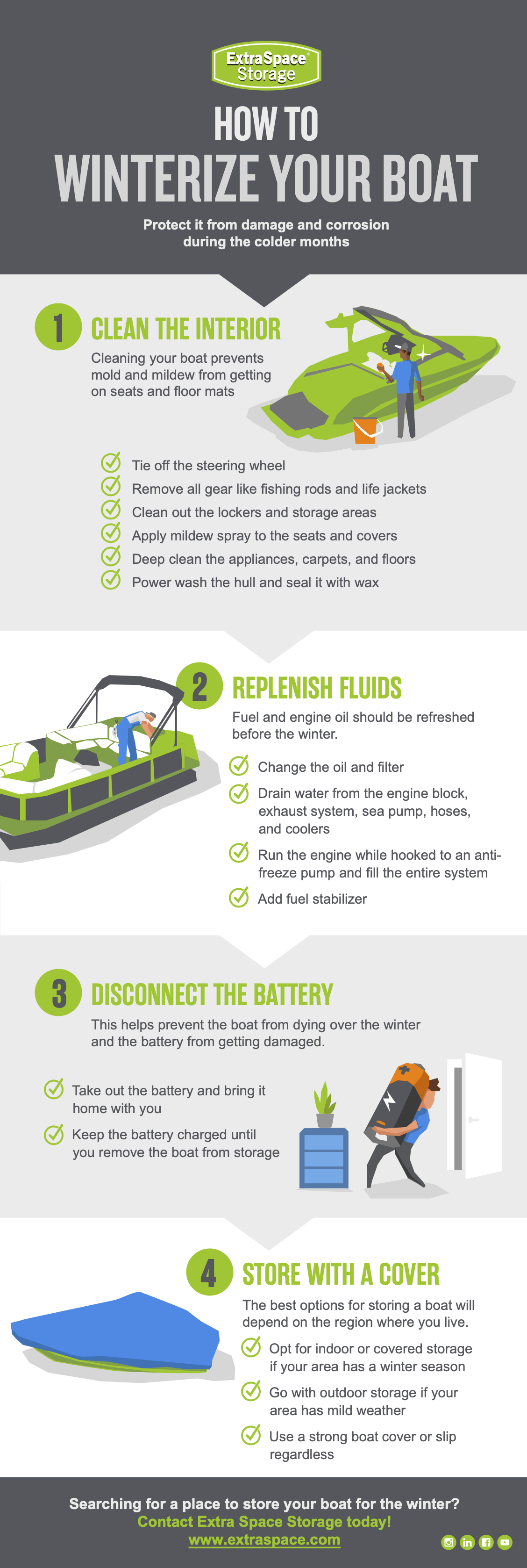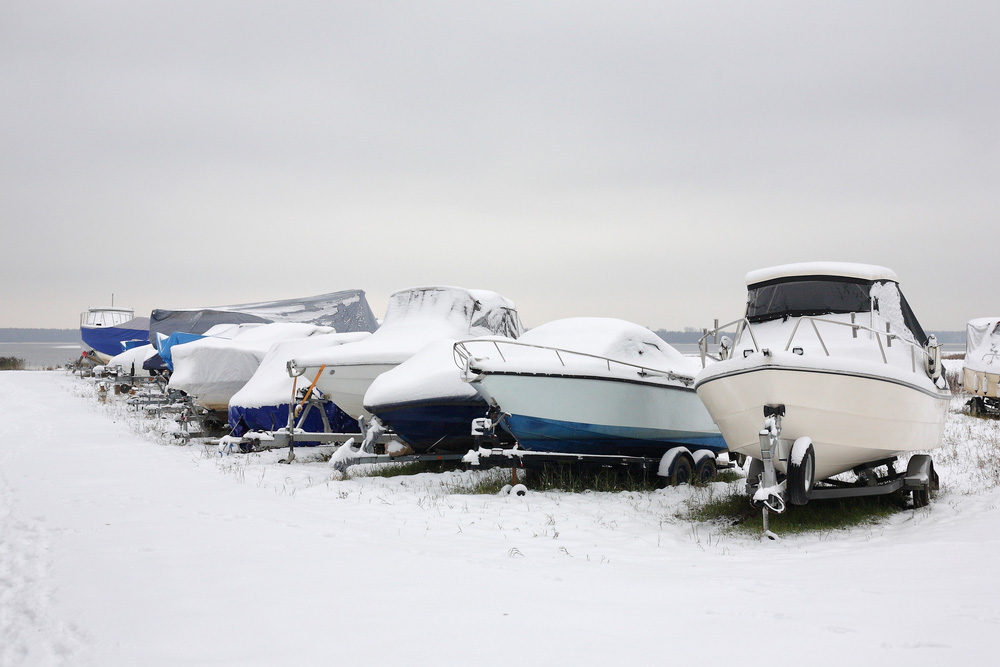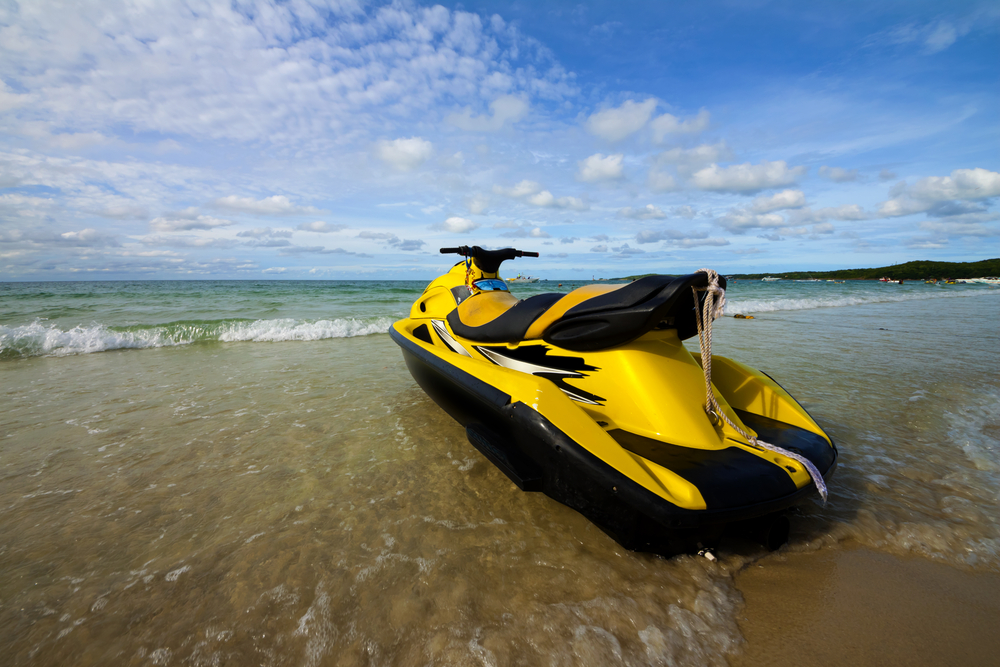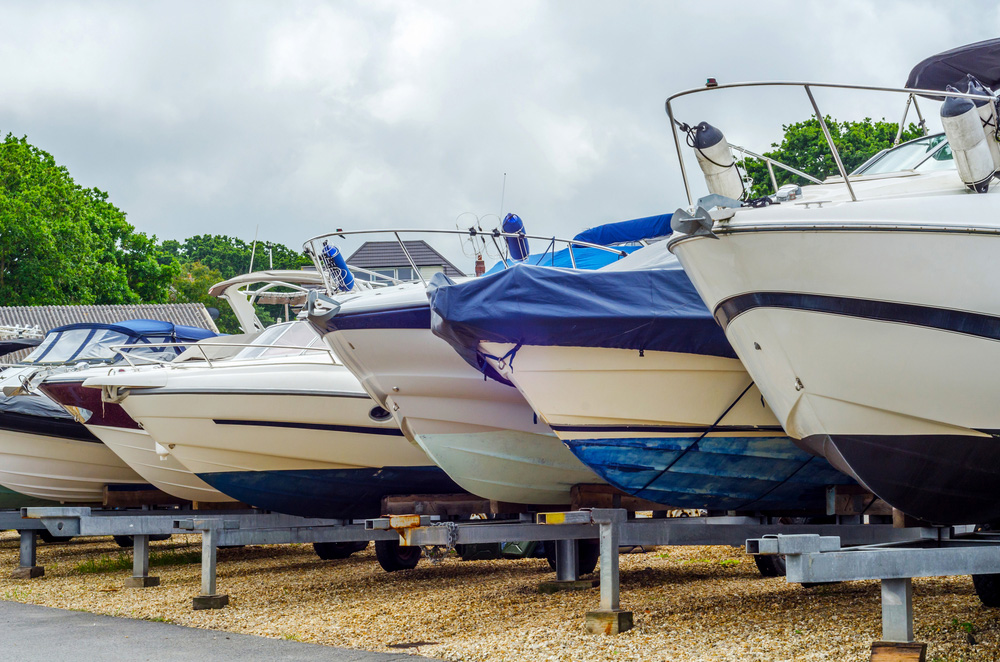Before deciding where to store your boat for the off-season, it’s important to winterize it to protect it from damage while in storage. Below, we share the necessary steps for winterizing a boat.
- Winterizing the Inside of a Boat
- Winterizing Boat Plumbing & Freshwater Systems
- Winterizing Inboard & Outboard Motors
- Winterizing the Sterndrive
- Preparing a Boat for Winter Storage
- Find the Best Boat Storage Option
Things You’ll Need
- Soap and water
- Wash rag or cloth
- Mildew spray
- Boat wax
- Antifreeze
- Fuel
- Engine oil
- Oil filter
- Gear lube
- Boat cover
Winterizing the Inside of a Boat
The first step in the boat winterization process is cleaning the inside of the boat. This prevents mold and mildew from developing on seats, floor mats, and other parts of your boat’s interior.
- Tie off the steering wheel.
- Remove all gear, such as fishing rods, lifejackets, tackle boxes, etc.
- Clean out lockers and storage compartments.
- Spray vinyl seats and covers with a mildew spray.
- Deep clean carpets, floors, and appliances inside the boat.
- Power wash the hull of the boat to get rid of buildup and seal with wax.
Winterizing Boat Plumbing & Freshwater Systems
If your boat has freshwater plumbing for a sink or shower, those systems will need to be winterized to prevent damage from freezing water.
- Buy antifreeze meant for freshwater sanitation systems (known as “the pink stuff“).
- Drain excess water from lines and tanks by opening fixtures.
- Remove the primary hose feed and place it into a bucket of antifreeze.
- Turn on every fixture and faucet until antifreeze comes out.
- Reattach your freshwater tank hose.
Winterizing Inboard & Outboard Motors
The biggest threats to a boat engine during the winter are freezing temperatures, fuel deterioration, and corrosion. Protect and prepare your boat’s engine for the cold with these easy steps.
How to Winterize an Inboard Boat Motor
- Change the oil while the engine is still warm.
- Remove the raw-water intake line and place it in a bucket of antifreeze.
- Run the engine until the antifreeze has gone through the entire engine.
- Use the flushing port to run cooling water through the engine.
- Remove the oil, change the filter, refill it, and make sure there are no leaks in the engine.
How to Winterize an Outboard Motor
- Change the lower-unit oil. This is an imperative step for outboard engines because any water left in the engine can cause serious damage when the temperature drops.
- Flush the cooling system and keep the engine tilted down.
- Depending on the make and model of your boat, you may need to change fuel or air filters.
- If you’re storing your boat for many months, make sure to use fogging oil in the engine.
Winterizing the Sterndrive
The sterndrive (or inboard/outboard drive) is the jet-propulsion system that helps power the motor and move the boat. Located just outside the hull, the sterndrive is a crucial component of your boat and needs to be thoroughly winterized.
- Inspect the sterndrive for cracks and remove any marine pests like barnacles.
- Drain residual water inside the drive.
- Run antifreeze with rust inhibitor through the raw-water systems in the drive. Keep it running until antifreeze comes out of the exhaust.
- Drain and replace gear lube in the lower-unit drive and inspect for excess water.
- If storing your boat outdoors, open cockpit drains but close all thru-hulls and seacocks.
- Check the propeller shaft for any damage, and check the operation of bilge pumps to make sure they’re free of debris.
- Use soap and water to clean the lower unit.
- Check fluid levels in steering pumps and make sure all fittings are lubricated.
- Plug exhaust ports to protect against water, snow, and pests.
Preparing a Boat for Winter Storage
After you’ve finished the other boat winterization steps, you’ll need to take care of the fuel and battery and find a boat cover. These are highly recommended before you move your boat to storage for the winter.
Step 1: Treat the Fuel
To prepare your boat for short-term or long-term vehicle storage, make sure to treat your fuel systems. Depending on your boat type, some manufacturers may suggest draining the fuel tank, while others suggest filling it. Either way, make sure to add stabilizer and change the water separators and fuel filters. The cost for fuel treatment generally runs between $5-$10.
Step 2: Remove the Battery
One of the most important steps before boat storage is taking care of the battery. It’s recommended that you keep the battery on a trickle charger to make sure it stays charged during the off-season.
Step 3: Apply a Boat Cover
Choosing the right cover will help protect your boat from damage while in vehicle storage. Plastic covers are the cheapest cover option, but they’ll only last a few seasons and are difficult to fit. Canvas covers are durable and slightly more expensive, but they’ll last considerably longer than plastic covers. Pre-fitted covers are the most expensive, but they’re available in all sizes and can be fit to your specific boat. If you would rather not cover your boat, shrink-wrapping is another option.
Find the Best Boat Storage Option
Looking for the best place to store a boat during the off-season? Depending on the region you live in and what kind of boat you have, you’ll need to consider either indoor or outdoor vehicle storage options!
Indoor Boat Storage Options
- Dry-Stacked Storage: Storing a boat inside a warehouse with stacked compartments keeps your boat secure and protected from the elements during the off-season.
- Garage Storage: Although you may have to move another vehicle outside to accommodate your boat, your garage at home provides both security and convenience at no cost.
- Indoor Storage Unit: By keeping your boat inside a storage unit at a self storage facility, you can rest assured your boat is well-protected throughout the winter.
Outdoor Boat Storage Options
- Parking in a Driveway: By far the most affordable option, parking your boat at home in your driveway is a convenient and free way to store your boat all winter long.
- Covered Storage Unit: Some self storage facilities offer covered vehicle storage, which provides a roof over your boat, giving it some protection from the elements.
- Uncovered Storage Unit: This vehicle storage option is essentially a designated parking space in a secure, fenced-in area at a self storage facility.
- Marina Slip: Otherwise known as “wet storage,” this outdoor storage option is ideal for boat owners who live in warmer regions where temperatures don’t dip below freezing.
- Boat Lifts: This convenient solution allows you to keep your boat at your dock but out of the water.
Planning to store a jet ski for the off-season? Learn more about jet ski winterization!
***
Need indoor, covered, or outdoor vehicle storage for your boat? Extra Space Storage has convenient storage facility locations throughout the U.S. Find affordable storage units near you!




